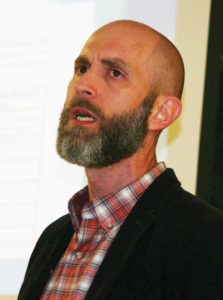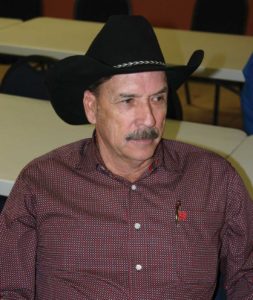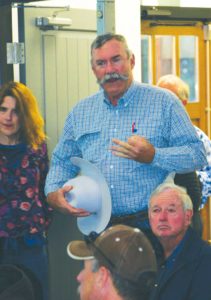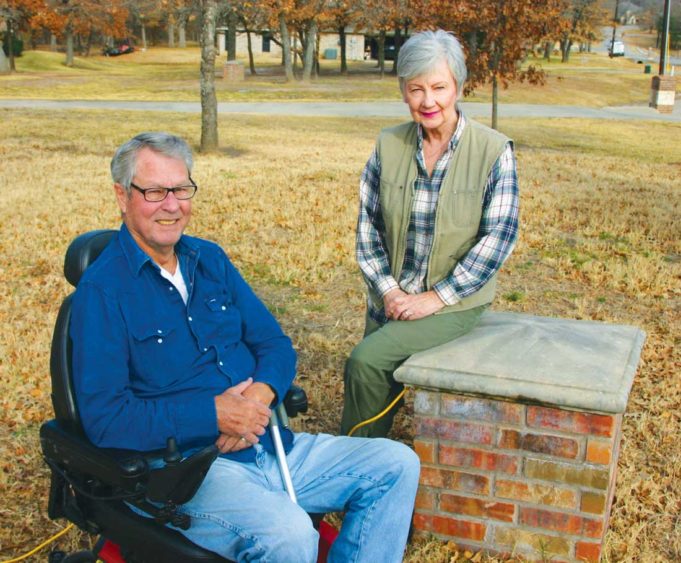The sprinkler system sprayed streams of water into an already soaked yard, splattering droplets into standing mud puddles. This was last week, a cold, rainy morning on the final day of 2018, and a year that saw this area receive its second highest annual rainfall amount – 56 inches – in recorded history.
And someone is watering his lawn?
Curious to pry into the mind of the homeowner, I knocked on the door. I had been driving through Windy Hill Estates III, northwest of Fort Worth near FM 1886 and Church Road in Parker County, just outside Fort Worth’s city limits but inside its extraterritorial jurisdiction, giving Cowtown the legal right to annex the area at some point.
Nobody answered. The upscale house was made from a combination of brick and rock. Large old-growth trees shaded the one-acre lot bordered by a long concrete driveway leading to a spacious barn. The surrounding houses were similarly large, pretty, and expensive.
I rang the doorbell and knocked again. No answer. Too bad. I wanted to hear the reason for using sprinklers needlessly in an area where some neighbors struggle to coax water from their faucets each day. Thousands of homeowners in Parker County rely on individual wells for water. In recent years, the pumps on some of those wells have been working longer and harder to refill the water tanks that homeowners rely on for showering, cooking, cleaning, and flushing.
“We have had to stop watering our lawn because we were running out of water in the house,” said Don Hunt, who moved with wife Frankye Hunt to Windy Hill Estates III about 10 years ago. “It’s scary. Whenever we flushed the commode, it would suck air. Whenever we tried to use the kitchen faucet, it would spurt and sputter.”
The groundwater that runs through aquifers buried beneath our North Texas landscapes is showing the strain of so many straws in the drink. Fort Worth was the country’s fastest growing large city between 2000 and 2010, with its population jumping from 535,000 to 740,000, according to the U.S. Census Bureau. The city is now expected to top a million people soon, and many of those hamsters on the wheel of life are choosing to move farther west into Parker County’s once rural areas.
Moving out there, in many cases, means drilling a water well for everyday needs. An estimated 25,000 private wells currently exist, with more than 600 a year being dug annually. Water officials say most of the private wells reach down into the Paluxy Aquifer. In Tarrant County, the Paluxy lies much deeper under the ground, but in parts of Parker County, the aquifer is only about 200 feet down. Well diggers charge by the foot, and tapping into the Paluxy in Parker County can be as cheap as $10,000. Digging in Tarrant County can cost two or three times as much. Most homeowners are on public water supplies fed by area lakes.
Once a well is drilled, water becomes free from that point forward, other than the cost of electricity to pump it out of the ground and into a holding tank.
And, boy, do folks pump. People accustomed to paying monthly water bills in Fort Worth and other cities move to unincorporated areas, and some make it their mission to water their large lots into lush green paradises. With aquifers losing volume and houses continuing to sprout for miles around, groundwater problems are becoming more common.

“More wells were drilled in Parker County than in any other county in the state,” said Doug Shaw, general manager of the Upper Trinity Groundwater Conservation District, a state-mandated organization that develops rules to protect existing water wells. District studies indicate North Texas aquifers are among the state’s most at-risk sources.
“Something has to give,” Shaw said. “Something has to be done.”
Doesn’t sound too hard.
Who would resist efforts to preserve precious water supplies?
Well, lots of people.
*****
The Hunts love the spacious home they purchased on a large one-acre lot on Natural Spring Lane in 2009. Area construction is still booming. Deer Glade, a planned subdivision with 143 new houses on two-acre lots, is currently slated to be built a couple of miles farther north, near Church Road and FM 730. That could prompt another 143 wells to be drilled.
The Hunts were among the first homeowners to settle in Windy Hill Estates III. Back then, Parker County required one acre of land to qualify for a private water well. Eventually, the law was bumped up to two acres to put more space between the wells. This meant homes would need twice as much land to qualify for a well. By then, however, Windy Hills III was built out with one-acre lots.
Water problems for the Hunts and a few neighbors began about three years ago.
“We had about three or four homes in our subdivision that had to re-drill their wells and go deeper because they ran out of water,” Don said. “The source is running out. We’re depleting our water table and causing it to drop down.”
Frankye described the hassle of relying on a well that struggles to pump groundwater into a holding tank.
“If you water the yard, you’ve got to do it early enough in the day and for a short enough period of time so that your well can recover so that you can shower and flush your commode and do a load of laundry, things that people don’t normally think about,” she said.
Not being able to do laundry might sound like a First-World problem, but think about it. These houses were built in areas without water lines. Without a well, you might be showering with bottles of Ozarka. A house is many people’s primary investment. Take away its water supply, and that house isn’t worth much. Imagine turning on a faucet for a drink or to cook dinner, and nothing comes out, leaving you with only a couple of fixes, namely using barrels to catch rainwater (a risky supply source in these parts), spending tens of thousands of dollars to dig your well deeper, or going to Sam’s Club to buy cases of Ozarka.
The Hunts and other homeowners rely on social media to spread the word about their problems, worries, and conservation efforts.
“We try to do everything we can,” Frankye said. “When our washer wore out, we went to the high-efficiency kind because it uses way less water. Back in the summer, the neighborhood put out an email saying, ‘Please stop watering your yard.’ Most everybody did a good job to comply. We all realize that taking a shower is more important than green grass.”
Drilling deeper into the Trinity Aquifer would cost the Hunts at least $20,000, the couple said. They would rather protect the groundwater they are currently tapped into.
Social media sites such as Nextdoor reveal a nervousness spreading among residents, particularly those along Church Road.
“Many people in this area are already experiencing the effects of a depleted water supply,” a resident named Mindy wrote on Nextdoor recently, encouraging her neighbors to contact their elected officials to seek more protection.
She, the Hunts, and most other homeowners are applauding the Groundwater Conservation District’s recent proposal to increase its acreage requirements yet again – from two acres to five.
Changing the rule “would be a good start,” Don said. “It would help a tremendous amount. We still could have serious problems with our water supply.”
In 2007, state legislators paved the way for the creation of groundwater conservation districts, and the Upper Trinity Groundwater Conservation District oversees Hood, Montague, Parker, and Wise counties. (Tarrant County is in the Northern Trinity Groundwater Conservation District.)
In November, the Upper Trinity District hosted a series of public hearings to gather feedback. As part of his presentation, the district’s Shaw described how water draws downward in the aquifer immediately surrounding a well. A five-acre rule reduces the chances that drilling a new well would impact any nearby wells, Shaw said.
“We know that [groundwater] is a depleting, declining resource, and that’s why groundwater districts exist – to ensure our kids and grandkids and their kids have water,” he said.
Most of the meetings were held during work hours on weekdays. People with commercial interests tended to outnumber the homeowners, something that didn’t go unnoticed on social media.
The district is “trying to advocate on behalf of residents and responsible development, but the only people attending their information meetings are angry developers/builders, real estate agents, and well-digging companies,” a resident named Mindy wrote on Nextdoor.
Her post included the email addresses of local and state officials.
“The people who live here and will be impacted need to speak up,” she wrote.
*****
I attended two of the district’s public meetings, and, as Mindy indicated, the crowds leaned toward those opposing a five-acre minimum. Landowners, developers, realtors, and well diggers expressed concerns that a five-acre requirement could hit their pocketbooks. A 100-acre pasture that could yield 50 new homes under the current law would result in only 20 new homes if the law was changed. Large parcels of land ripe for development won’t be worth as much as a result. That might mean fewer profits for landowners who sell to developers, less jingle for developers building the houses, and fewer tax revenues for the county.
In bean counter-speak, that’s a lose-lose-lose situation.
Critics say the district relies on inexact science in guessing about the future availability of groundwater.
“I encourage water users to challenge every fact about groundwater that the district alleges,” said Mark McPherson, a Dallas attorney who specializes in water issues and represents developers and the energy industry in many cases.
McPherson said the district relies on studies performed by the Texas Commission on Environmental Quality and others. Some studies were generated back when natural gas drillers were swarming the Barnett Shale play and tapping into area aquifers more heavily than now and the state was experiencing drought years.
“The powers-that-be looked at that and said, ‘Oh, my lands, we need to have groundwater districts over the Trinity immediately because all of these terrible things are going to happen in the future,’ ” McPherson said.
District studies show that a small percentage of rainfall makes its way into the ground deep enough to recharge the aquifers and that far greater amounts of water are being removed than recharged.
McPherson isn’t convinced, citing other studies that he deems far less dramatic.
“I don’t think we understand the hydrology enough and don’t give enough credit to recharge,” he said. “We go through periods of drought and flood and seem to get more severe weather these days. Drought can affect aquifers, but when you take enough years into account and don’t limit your analysis just to periods of drought, the recharge is pretty good. Rain water really helps the Trinity and brings it back to life pretty quickly.”
During the November 10 meeting in Weatherford, I sat next to Parker County Commissioner George Conley and discussed the district proposal. Elected officials such as Conley are trying to please people on various sides of the debate, although the officials are mostly powerless when it comes to fighting the district
In 1957, legislators created the Texas Water Development Board to protect the state’s water sources. In 2006, while oil and gas drillers were sucking millions of gallons of water from the ground to use in the fracking process, the water board noted that counties in North Central Texas were experiencing groundwater troubles. Some homeowners complained that their water wells went dry and their pumps began sucking mud after fracking operations set up nearby.
A dozen years later, aquifers are continuing to trend downward, say district officials, who are pushing developers to rely more on surface water. One way to accomplish that is to make it costlier to tap into groundwater.
The Upper Trinity was the first district given the ability to charge the oil and gas industry for the groundwater used in drilling operations. By 2009, the district was enforcing spacing regulations between wells and setbacks from property lines. Only new wells were required to be registered and permitted. Existing domestic wells have been grandfathered and exempted, leaving the district without power to rein in all the dummies who run their sprinkler systems on rainy winter days.

Conley is serving his third term as Parker County commissioner but until recently worked as a water well driller. When he first started digging wells 30 years ago, he said, people worried that the local aquifers were running dry. All these years and many wells later, he said, groundwater is still providing comfort to hundreds of thousands of local residents. He believes Parker County’s aquifers are among the strongest around.
District studies that indicate a depletion of water levels do not impress Conley much.
“They are using data from engineers,” he said. “Engineer stuff sounds good on paper, but it’s not always the way it is.”
Developers are pushing Conley and other officials to fight against the district’s proposal.
“All my water well buddies are on me about this five-acre deal,” Conley told me. “The developers don’t want the five acres. They raised Cain when it went to two acres.”
During the district meeting in Weatherford, critics kept asking Shaw what the district was doing to develop alternative water sources. The district, though, is designed to monitor and preserve groundwater, not to develop comprehensive water plans that involve surface and public supplies, Shaw said. The district’s primary regulatory authority for protecting groundwater is limiting the number of wells.
Shaw’s response sounded like a cop-out to some in the crowd, who wanted more proactive measures, so two county officials – Parker County Commissioner Larry Walden and Judge Pat Deen – showed up at a subsequent district meeting on November 19 in Springtown to make a proposal.
Deen chose his words carefully.
“The history of this has been that the county has really not been a very – and no disrespect to anybody in the previous … ” he began but then changed his approach.
He said Parker County officials are considering hiring Freese and Nichols, an infrastructure consultant firm, to oversee the development of a water plan for reducing the demand on groundwater.
“We are a team player with you,” Deen said. “We want to be good stewards of our water. What I ask and urge you to do is allow us to explore this with Freese and Nichols, establish a water policy, and make sure we work with you to find solutions before you drop what I consider an atomic bomb, because once you [enact the five-acre rule], it changes the dynamics of our county dramatically.”
The meeting room was so packed with people that Walden couldn’t find a seat. He stood in the doorway with his cowboy hat in his hand and appealed to the district’s board members to delay increasing the acreage until local officials had time to develop alternative measures.
“I asked you guys to be the leaders the other day in coming up with solutions,” Walden told them. “The judge and I, not hearing anything from you, decided we would take the lead in Parker County and try to form a coalition of people who are stakeholders interested in solving this well problem by replacing it with surface water.”
The reason is simple.
“We seriously are concerned about the economic impact to our county and property values,” he said.
*****
Soon after the meeting in Springtown, Parker County commissioners created an alliance with cities and public water entities to gather information. The commissioners approved spending $15,000 with Freese and Nichols to create a plan for battling potential water shortages without throwing wheel spikes in front of the speeding vehicle that is residential development.
The move bought county officials a 90-day reprieve from the district, meaning the five-acre rule is on hold for now.
During a recent conversation with me, Walden said Parker County residents and builders have relied on groundwater for too long. He doesn’t doubt the district’s studies that show groundwater levels are decreasing, particularly around subdivisions abundant with wells.
“We would like to have some more time so we can formulate a strategic water plan for Parker County that will shift the reliance on well water to more of a reliance on surface water,” he said. “To my knowledge, we have never had a county water plan.”
The five-acre rule would reduce the value of large tracts of land and create “repercussions all up and down the scale,” he said.
The alliance of stakeholders – cities, water companies, special utility districts, municipal water districts, school districts, and many others – will attempt to create a plan to expand surface water supplies. That doesn’t mean building a new lake, which can be a decades-long effort, he said.
The plan might consider expanding reverse osmosis plants or piping water in from nearby sources, he said.

The opinions of residents are “all over the spectrum,” he said. “People that already have a well, there is going to be some that say, ‘I’ve got mine, but I don’t want you to have yours.’ There are others that say, ‘Gosh, we don’t want to have to buy five acres if we want to build a house.’ What it does is exclude people that can’t afford the five acres.”
Parker County officials will present the water plan to district board members later this year. Walden doesn’t know what the plan will say, but he knows that the population is increasing and people need to approach water issues differently in the future.
“We are going to have development here,” Walden said. “You can debate whether it’s two acres or five acres. The fact that we’re going to have information and we’re going to begin a process, we can get some people focused on making some change.”













I’m surprised you didn’t burn their house down and kill their dog. That’s what hysterical Liberals usually do, right?
You’re the only one sounding hysterical, “Bob.”